Chemistry
Introduction to Atmospheric Chemistry
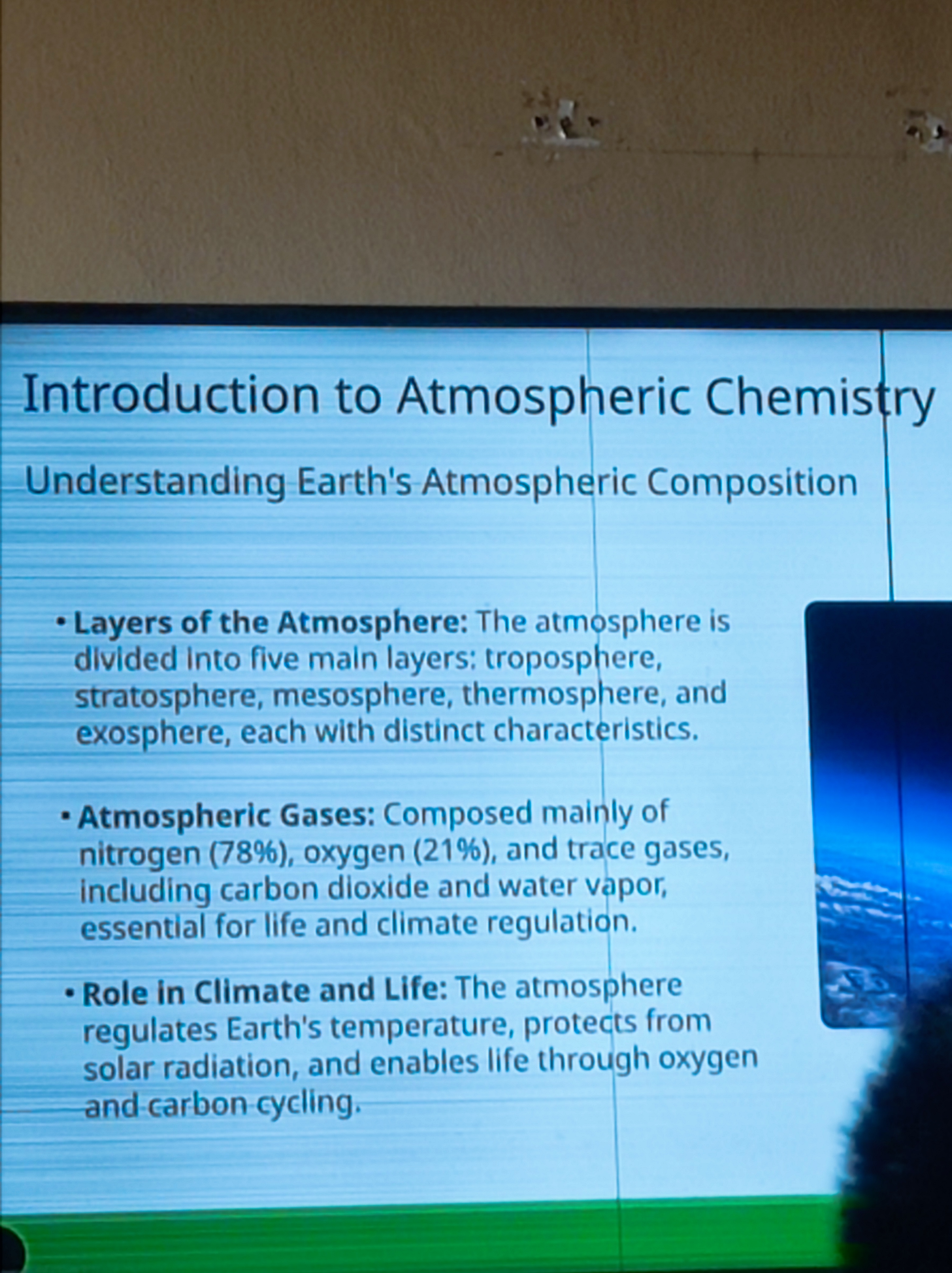
Understanding Earth's Atmospheric Composition
Layers of the Atmosphere
- The atmosphere is divided into five main layers:
- Troposphere: The lowest layer where weather occurs.
- Stratosphere: Contains the ozone layer, which absorbs UV radiation.
- Mesosphere: The middle layer where temperatures drop.
- Thermosphere: Temperature increases with height; contains the ionosphere.
- Exosphere: The outermost layer, where atmosphere thins into space.
Insights:
- Each layer has distinct characteristics affecting temperature, pressure, and composition.
- Understanding these layers is crucial for meteorology and climate studies.
Atmospheric Gases
- Composed mainly of:
- Nitrogen (78%) : Inert gas, doesn’t easily react, but crucial for the nitrogen cycle.
- Oxygen (21%) : Essential for respiration, supporting life.
- Trace Gases: Includes carbon dioxide and water vapor; critical for climate regulation and sustaining life.
Additional Information:
- Trace gases, though in small amounts, have significant impacts on the greenhouse effect and climate change.
- Water vapor is the most abundant greenhouse gas, playing a key role in weather processes.
Role in Climate and Life
- The atmosphere regulates Earth's temperature and protects from harmful solar radiation.
- It enables life through:
- Oxygen and Carbon Cycling: Processes that maintain life-supporting conditions.
Insights:
- The greenhouse effect, primarily from gases like CO2 and methane, stabilizes Earth's climate but can also lead to global warming if unchecked.
- Ozone in the stratosphere is crucial for UV protection, highlighting the importance of environmental policies that prevent ozone depletion.
By understanding these key components, we grasp not only how the atmosphere sustains life but also the impact of human activities on atmospheric conditions.
Extended readings:
The Nitrogen Cycle
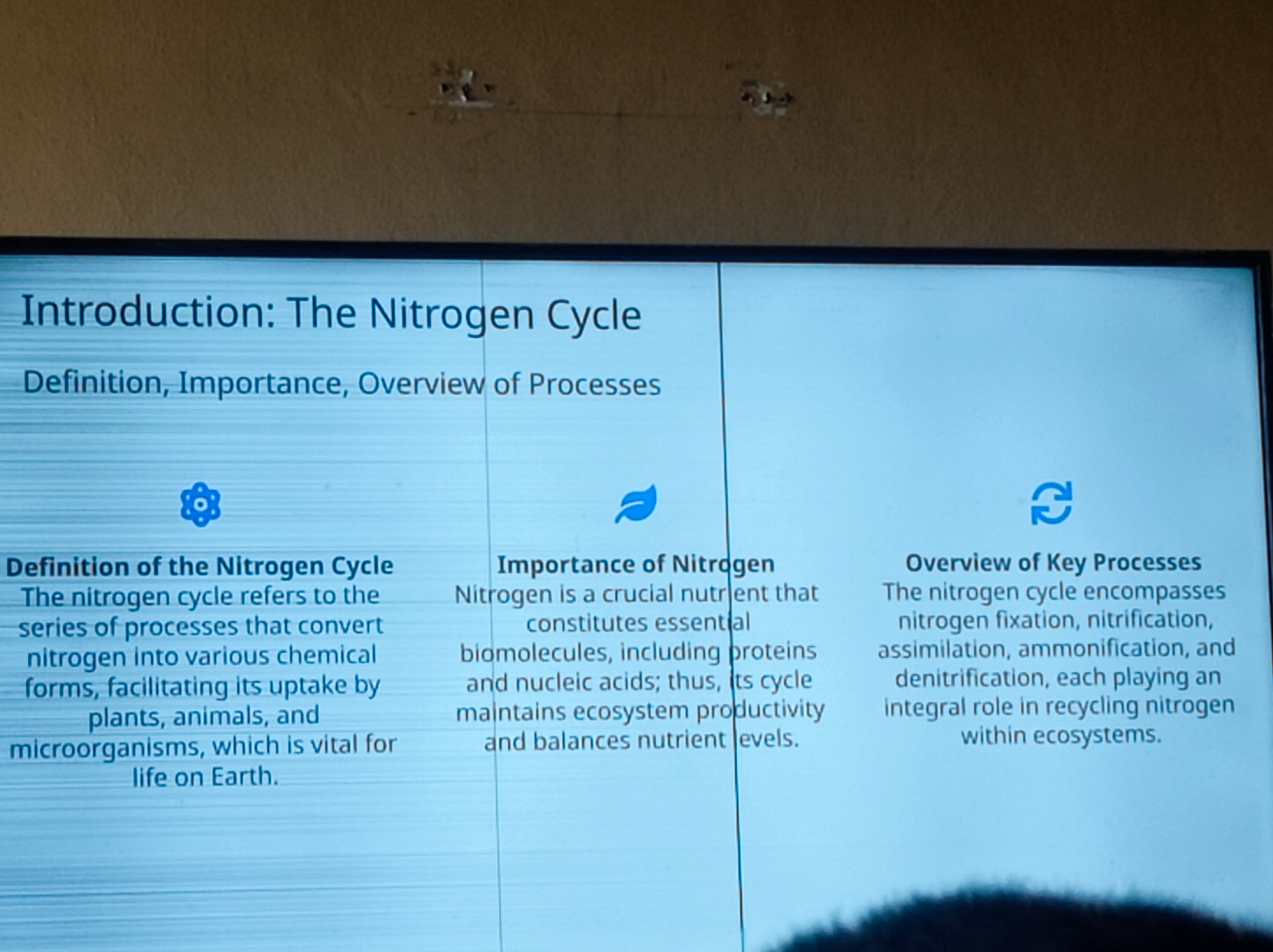
Importance of Nitrogen
- Essential Nutrient:
- Nitrogen is crucial for the formation of essential biomolecules, such as proteins and nucleic acids.
- Proteins: Large molecules necessary for the structure, function, and regulation of the body’s tissues and organs.
- Nucleic Acids: DNA and RNA, which carry genetic information.
- Ecosystem Impact:
- The nitrogen cycle helps maintain ecosystem productivity and balance nutrient levels.
- Ecosystem Productivity: The rate at which plants and other photosynthetic organisms produce organic compounds in an ecosystem.
Overview of Processes
-
Nitrogen Cycle: A sequence of processes through which nitrogen is converted into various chemical forms as it circulates among the atmosphere, terrestrial, and marine ecosystems.
-
Key Processes:
- Nitrogen Fixation: Atmospheric nitrogen is converted to ammonia by bacteria, making nitrogen accessible to plants.
- Nitrification: Ammonia is converted into nitrites, then nitrates by bacteria, usable by plants.
- Assimilation: Plants absorb nitrates from the soil to build plant proteins and nucleic acids.
- Denitrification: Conversion of nitrates back to atmospheric nitrogen, completing the cycle.
Additional Information
-
Biological Nitrogen Fixation:
- Carried out by symbiotic bacteria in the soil or plant roots, like Rhizobium.
- Important in agriculture to enrich nitrogen in the soil without chemical fertilizers.
-
Human Impact:
- Industrial activities, such as fertilizer production and fossil fuel combustion, can alter the nitrogen cycle.
- Excessive use of fertilizers can lead to nutrient runoff and eutrophication in water bodies.
Understanding the nitrogen cycle is crucial for environmental science, agriculture, and managing ecosystem health.
Extended readings:
Parts of the Nitrogen Cycle
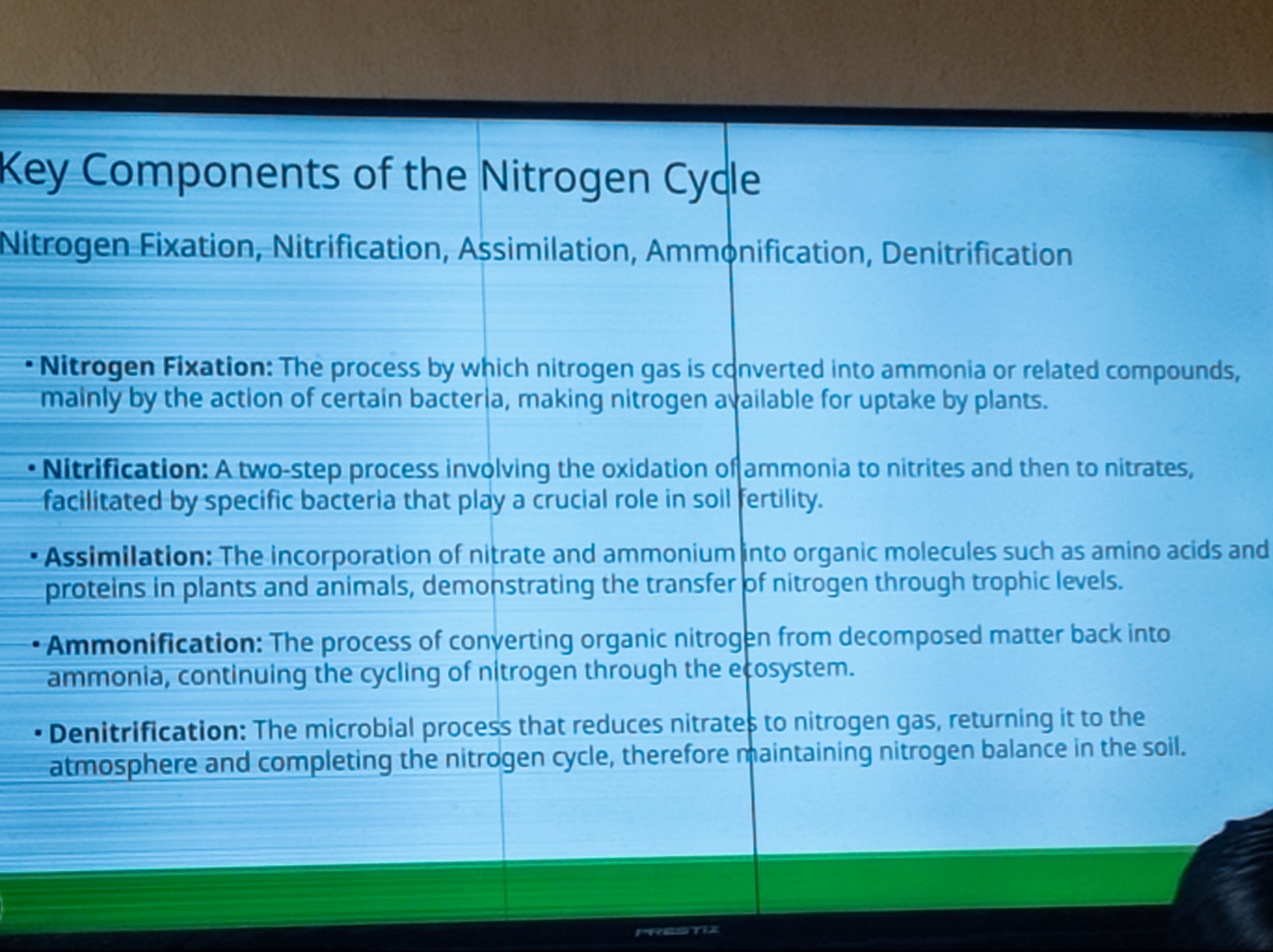
Key Processes
-
Nitrogen Fixation
- Definition: The process by which nitrogen gas is converted into ammonia by certain bacteria.
- Insight: This step makes nitrogen available for plant uptake, as atmospheric nitrogen is not directly usable by most organisms.
- Additional Information: Nitrogen-fixing bacteria, such as Rhizobium, are often found in symbiotic relationships with leguminous plants.
-
Nitrification
- Definition: A two-step process involving the oxidation of ammonia to nitrites and then to nitrates.
- Importance: Fuels soil fertility by making nitrogen accessible to plants in a usable form.
- Additional Information: Nitrifying bacteria, such as Nitrosomonas and Nitrobacter, play a key role in this process.
-
Assimilation
- Definition: The incorporation of nitrate and ammonium into organic molecules by plants and animals.
- Insight: Demonstrates the transfer of nitrogen through different trophic levels in an ecosystem.
- Additional Information: This process connects the nitrogen cycle with the food chain, impacting plant and animal growth.
-
Ammonification
- Definition: The process of converting organic nitrogen from decomposed bodies and waste into ammonia.
- Importance: Contributes to the cycling of nitrogen through the ecosystem by breaking down organic materials.
- Additional Information: Involves decomposers such as fungi and bacteria.
-
Denitrification
- Definition: A microbial process that reduces nitrates to nitrogen gas, returning it to the atmosphere.
- Importance: Completes the nitrogen cycle and maintains nitrogen balance in the environment.
- Additional Information: Denitrifying bacteria, such as Pseudomonas, are responsible for this anaerobic process, helping to prevent the accumulation of nitrates in environments.
Summary
The nitrogen cycle is essential for converting atmospheric nitrogen into forms accessible to living organisms and subsequently returning it to the atmosphere. This cycle supports plant growth, ecosystem productivity, and soil health, and plays a vital role in maintaining environmental balance. Understanding the roles of different bacteria and stages in this cycle is crucial for fields like agriculture and environmental science.
Extended readings:
The Oxygen Cycle: Understanding Its Significance
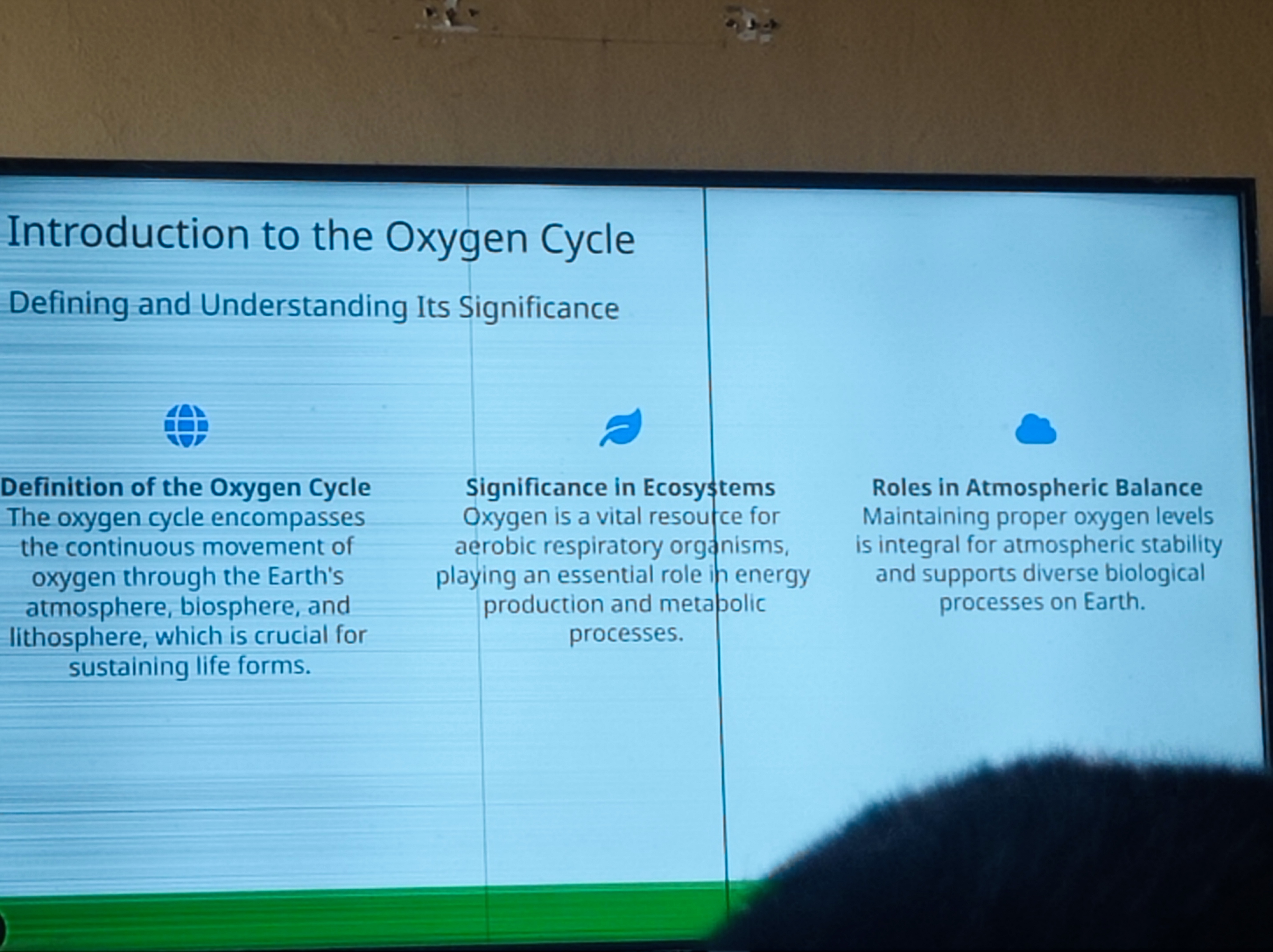
Significance in Ecosystems
-
Vital Resource for Aerobic Organisms
- Oxygen is crucial for the survival of aerobic organisms, which rely on it for respiration.
- Aerobic Respiration: A process where cells use oxygen to produce energy in the form of ATP (adenosine triphosphate).
- Energy Production: Oxygen is key in cellular respiration, converting glucose and oxygen into energy, carbon dioxide, and water.
-
Role in Metabolic Processes
- Essential in facilitating metabolic activities across various life forms.
- Metabolism: The sum of all chemical reactions that occur in living organisms to maintain life, including catabolism (breaking down molecules to obtain energy) and anabolism (using energy to construct components of cells such as proteins and nucleic acids).
Additional Insights
- Cycle of Oxygen: Part of the larger biogeochemical cycles, sustaining life by circulation between biological, geological, and chemical processes.
- Photosynthesis: In contrast to respiration, plants produce oxygen as a byproduct, which is essential for replenishing Earth's atmosphere with oxygen.
- Environmental Impact: Understanding the oxygen cycle aids in grasping ecological balances and addressing issues like deforestation and pollution which impact oxygen production.
By maintaining a balance in the oxygen cycle, ecosystems support a robust and diverse range of life forms.
Extended readings:
The Oxygen Cycle: Key Processes
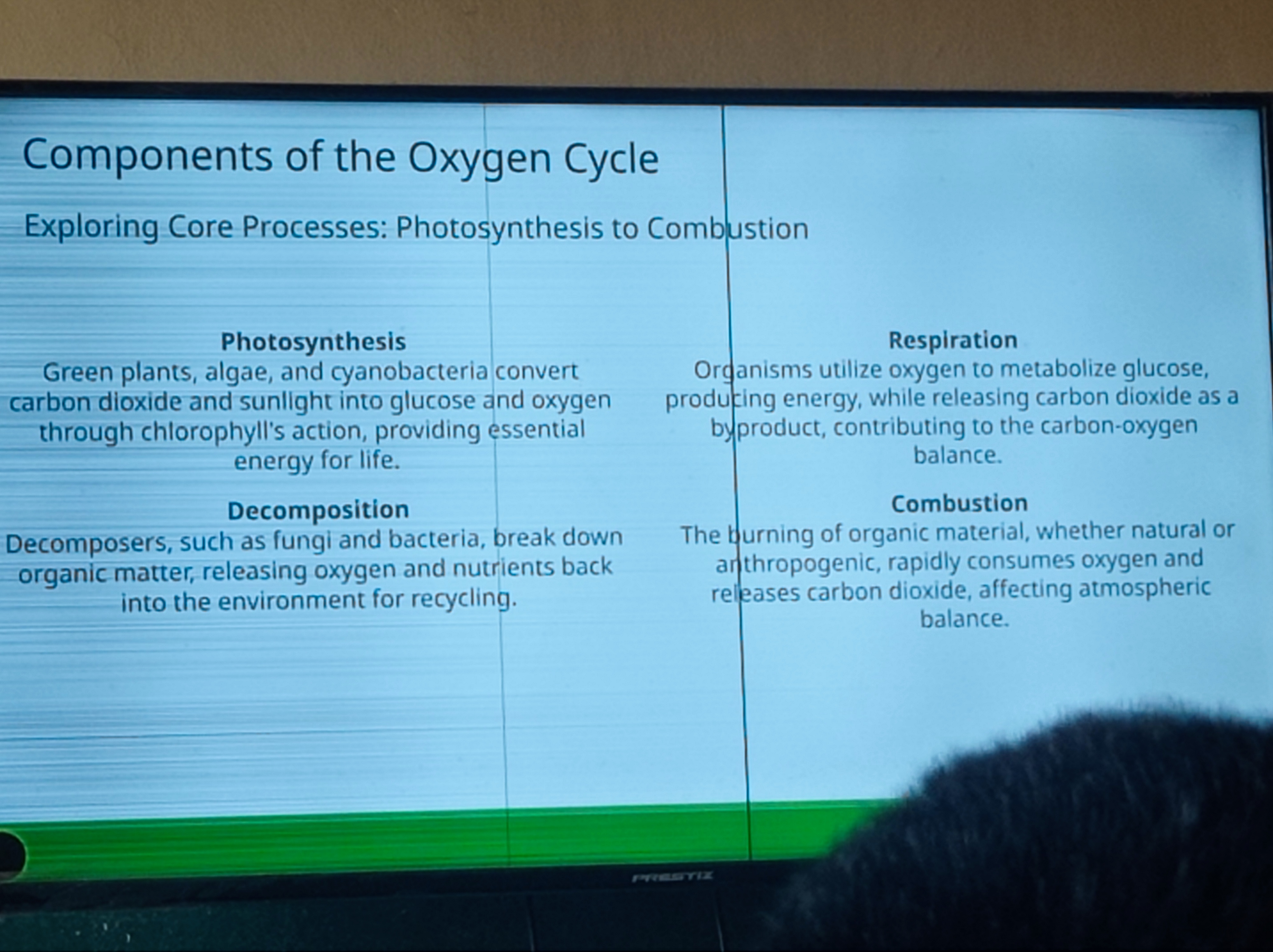
Photosynthesis
- Definition: Plants and cyanobacteria convert sunlight into glucose and oxygen.
- Importance: This process provides essential energy for life and sustains the atmosphere with oxygen.
- Additional Insights: Photosynthesis plays a crucial role in removing carbon dioxide from the atmosphere, thus helping to regulate global temperatures.
Respiration
- Definition: Organisms utilize oxygen to produce energy, releasing carbon dioxide as a byproduct.
- Role in Balance: Contributes to the oxygen-carbon dioxide balance in the ecosystem.
- Additional Information: Cellular respiration is a vital metabolic process in which cells extract energy from nutrients, crucial for the survival of all aerobic life.
Decomposition
- Definition: Fungi and bacteria break down organic matter, returning oxygen and nutrients to the environment.
- Recycling Role: Ensures the continuity of nutrients within ecosystems, supporting new life.
- Additional Insights: Decomposition is critical for soil health, as it replenishes essential nutrients required for plant growth.
Combustion
- Definition: The burning of organic material, both natural and anthropogenic, rapidly consumes oxygen and releases carbon dioxide.
- Impact on Balance: Affects the balance of gases in the atmosphere, contributing to climate change.
- Additional Information: Combustion processes are a significant source of air pollution and greenhouse gases, highlighting the importance of sustainable energy practices.
These processes are interconnected and vital for maintaining ecological balance and supporting life on Earth. Understanding each process helps in raising awareness about environmental impacts and the need for conservation efforts.
Extended readings:
Environmental Chemistry: Ozone Layer Challenges
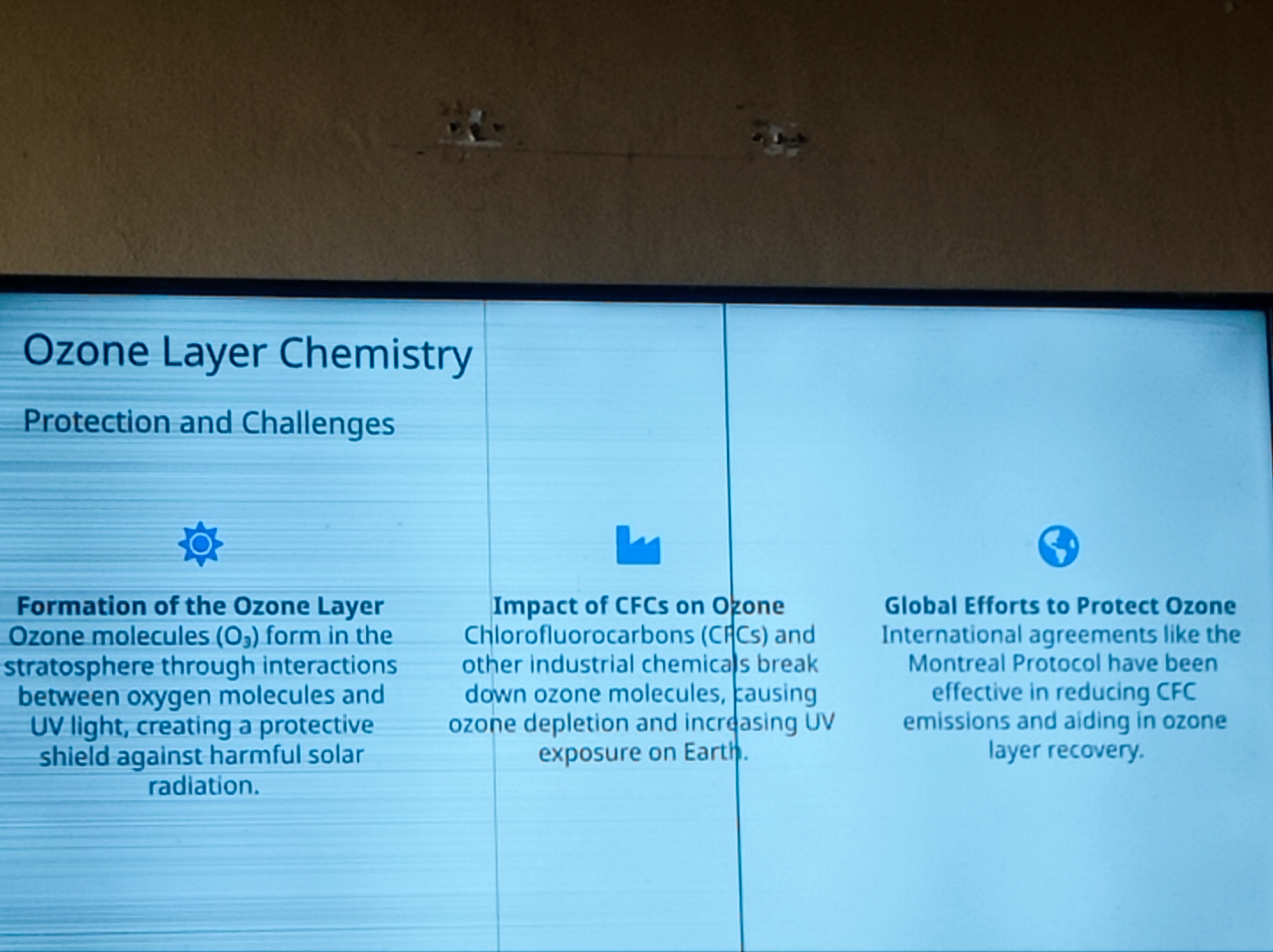
Impact of CFCs on Ozone
-
Chlorofluorocarbons (CFCs):
- CFCs are industrial chemicals used in refrigerants, foam blowing agents, and solvents.
- Insight: These compounds are stable, odorless, and nonflammable, contributing to their widespread use.
-
Ozone Depletion:
- CFCs break down ozone molecules in the stratosphere.
- Additional Info: The chemical reaction involves the release of chlorine atoms, which catalyze the breakdown of ozone (O₃) into oxygen (O₂).
-
Increased UV Exposure:
- Loss of ozone leads to higher levels of ultraviolet (UV) radiation reaching Earth's surface.
- Insight: This increase in UV exposure can lead to health concerns like skin cancer and cataracts, as well as affect ecosystems, particularly marine life and photosynthetic organisms.
Additional Context
-
Global Response:
- Understanding CFCs' impact led to international agreements like the Montreal Protocol, which successfully phased out the production and use of CFCs globally.
- Additional Info: This international treaty is often cited as one of the most successful environmental agreements, showing the impact of coordinated global action.
-
Alternatives to CFCs:
- Replacements include hydrochlorofluorocarbons (HCFCs) and hydrofluorocarbons (HFCs), though these also have environmental concerns.
- Insight: Continued research and development focus on finding more sustainable alternatives with lower environmental impacts.
-
Related Atmospheric Chemistry:
- Ozone acts as a protective layer against solar radiation, allowing life to thrive.
- Understanding these interactions is crucial for preserving this delicate balance and protecting living organisms from harmful effects.
This overview of the impact of CFCs on the ozone provides a foundational understanding of atmospheric chemistry and the global efforts taken to mitigate this environmental issue.
Extended readings:
Climate Change and Greenhouse Effect
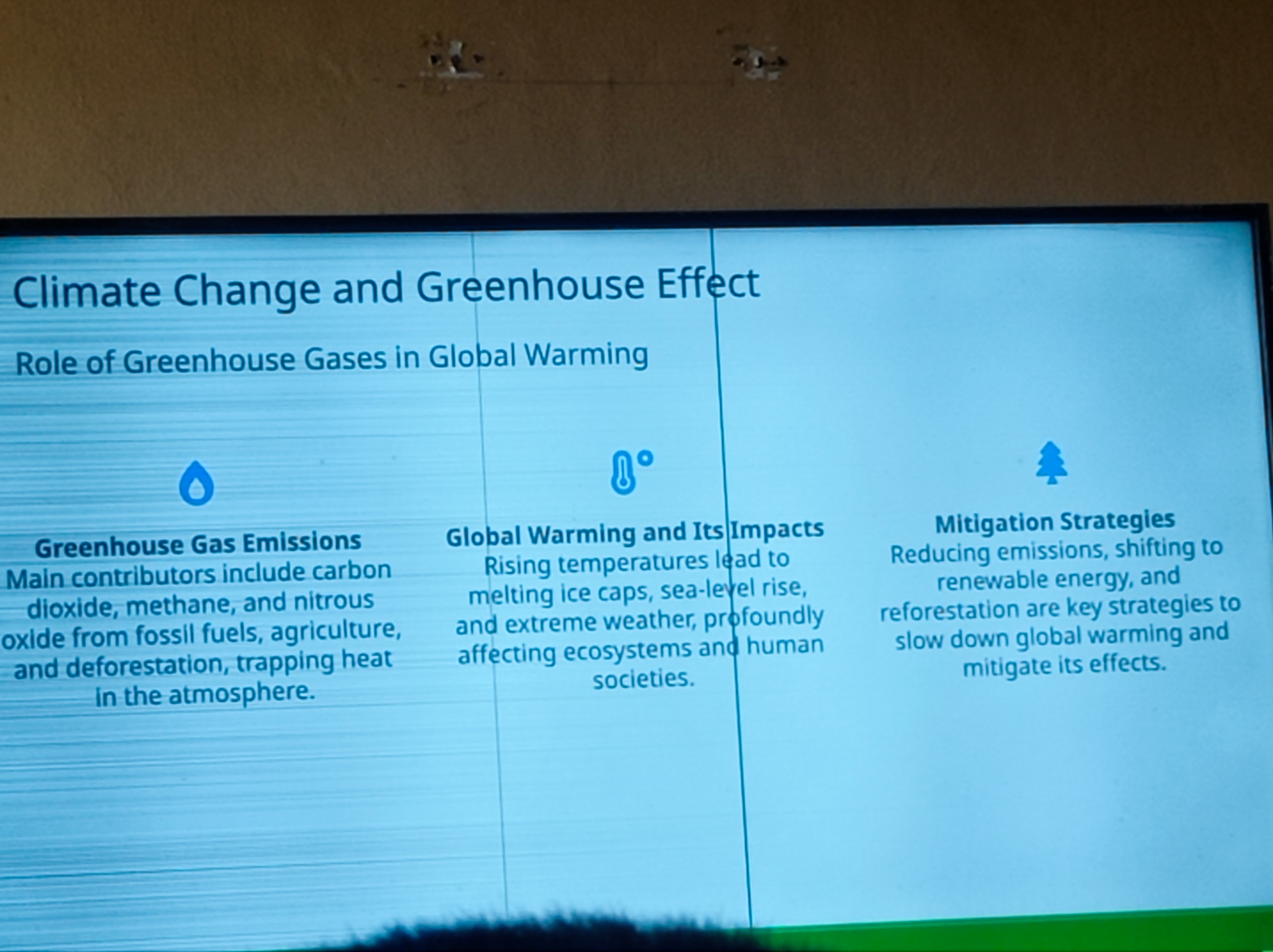
Key Points
Greenhouse Gases in Global Warming
- Definition: Greenhouse gases trap heat in Earth's atmosphere, leading to global warming.
- Common Greenhouse Gases: Carbon dioxide (CO2), methane (CH4), nitrous oxide (N2O), and fluorinated gases.
- Importance: These gases amplify the natural greenhouse effect, causing more heat to be retained and increasing global temperatures.
Global Warming and Its Impacts
- Rising Temperatures: Elevated global temperatures contribute to a range of environmental changes.
- Melting Ice Caps: Accelerated melting of polar ice caps leads to rising sea levels, threatening coastal communities and ecosystems.
- Sea-Level Rise: Increases the risk of flooding and habitat loss, impacting millions of people worldwide.
- Extreme Weather: Intensified storms, droughts, and heatwaves disrupt ecosystems and human societies, challenging adaptation and resilience efforts.
- Ecosystem Effects: Altered habitats and biodiversity losses affect food security and ecosystem services vital for human survival.
Mitigation Strategies
- Emission Reduction: Implementing policies and technologies to reduce carbon footprint.
- Renewable Energy: Transitioning to solar, wind, and other renewable energy sources.
- Reforestation: Planting trees to absorb CO2, restoring natural carbon sinks.
- Sustainable Practices: Encouraging sustainable agriculture, transportation, and waste management to slow down climate change impacts.
Additional Insights
- The Role of Sustainable Development: Achieving a balance between economic growth and environmental protection is crucial for long-term sustainability and tackling climate change.
- International Cooperation: Global agreements like the Paris Agreement aim to unite nations in reducing emissions and supporting climate adaptation initiatives.
- Public Awareness and Education: Raising awareness among communities about the impacts of climate change and ways to mitigate it can drive collective action.
Understanding the multifaceted nature of climate change and its effects can empower individuals and communities to engage in proactive solutions and support policy change to secure a healthier planet for future generations.
Extended readings: